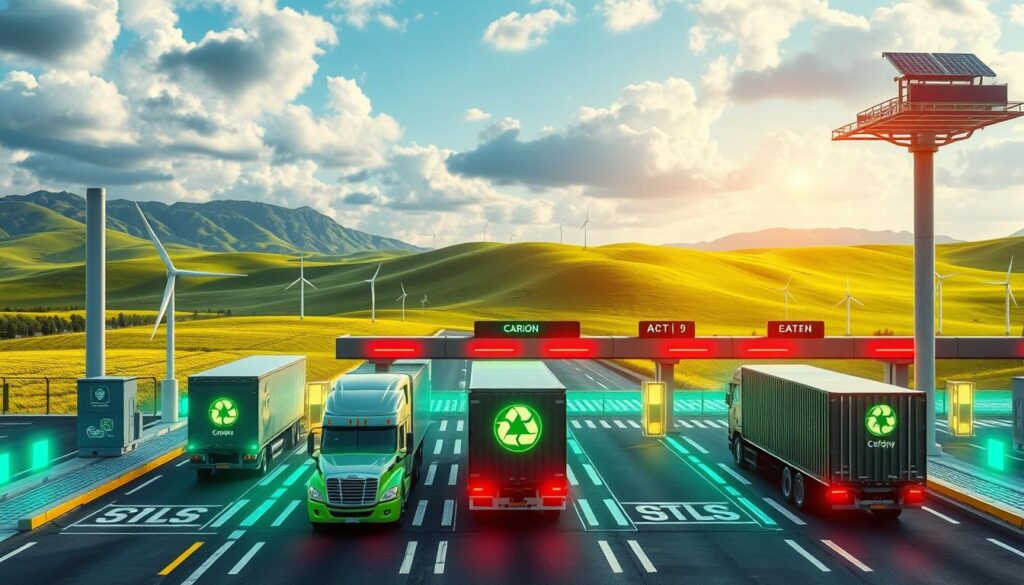International trade law is key in fighting climate change. It encourages sustainable practices and lessens climate change’s effects. It helps countries work together to reduce climate change’s impact.
It sets up rules for countries to follow. This way, they can trade in a way that’s good for the planet.
As we look at how trade and climate change connect, we’ll see how trade law can help. The growth of green rules in trade deals is important.
We’ll talk about the link between trade and climate change. We’ll also cover how trade law has evolved to address climate change. By exploring these areas, we’ll understand how trade law can fight climate change and support green practices.
Understanding the Intersection of International Trade and Climate Change
International trade is a big part of the global economy. But it also affects the environment a lot. Climate change is happening everywhere, and trade rules are being looked at again. It’s important to understand how trade and the environment connect to make good climate policies.
The Global Trade-Environment Relationship
The link between global trade and the environment is complex. Trade can harm the environment, like through emissions from moving goods. But it can also help by sharing green technologies.
Key Environmental Challenges in International Commerce
There are big environmental issues in international trade, like:
- Climate change impacts on supply chains
- Pollution from transportation and production
- Resource depletion and waste management
Economic Implications of Climate-Focused Trade Policies
Climate-focused trade policies can cost businesses more and might block trade. But they can also open up chances for green trade and growth. By getting how trade and climate change work together, we can make better rules for a sustainable future.
The Evolution of Environmental Provisions in Trade Agreements
Environmental provisions in trade agreements have changed a lot over time. Now, there’s a big push for sustainability agreements. These agreements help make trade more eco-friendly and reduce harm to the environment.
Adding environmental rules to trade deals has many benefits. It helps protect nature, supports sustainable growth, and improves how we manage the environment.
Some big successes in sustainability agreements are the Paris Agreement and CITES. These show countries are serious about tackling environmental issues and promoting green trade. But, making sure these rules are followed is still a big problem.
To solve this, countries can do a few things. They can make environmental laws stronger, make trade more open and fair, and involve more people in environmental decisions.
- Strengthening environmental regulations and standards
- Enhancing transparency and accountability in trade practices
- Promoting public participation and awareness in environmental decision-making
By adding sustainability agreements to trade deals, countries can work towards a better future. This change is a step in the right direction. But, we need to keep working to overcome the challenges and seize the opportunities.
The Role of International Trade Law in Addressing Climate Change
International trade law is key in fighting climate change. It encourages sustainable practices and lessens trade’s environmental harm. The World Trade Organization (WTO) has set up environmental rules to tackle climate change.
These rules help balance free trade with protecting our planet. They make sure international trade doesn’t harm the environment too much.
The WTO has rules for trade and the environment. It uses trade measures to enforce green agreements. Regional trade deals also have green clauses to support eco-friendly trade.
Bilateral agreements focus on specific environmental issues, like cutting down on greenhouse gases. These steps show how important working together is in solving trade and environmental problems.
WTO Environmental Regulations
- Implementation of environmental impact assessments for trade agreements
- Establishment of trade measures to enforce environmental agreements
- Promotion of sustainable trade practices through technical assistance and capacity building
International trade law helps make global trade more sustainable and green. Adding environmental concerns to trade agreements is crucial. It helps fight climate change and aims for a greener future.
Carbon Border Adjustments and Trade Measures
As the world moves towards climate action strategies, governments are finding new ways to cut carbon emissions. They are promoting sustainable trade practices too. One method is carbon border adjustments, which help domestic industries and push other countries to follow global trade regulations.
Carbon border adjustments are based on the idea that climate change is a global problem. It needs a united effort from countries everywhere. By using carbon pricing, countries can encourage companies to lower their carbon output. This helps in reducing the risk of carbon leakage.
Understanding Carbon Pricing Mechanisms
Carbon pricing, like carbon taxes or cap-and-trade systems, adds a cost to carbon emissions. It gives companies a reason to cut their carbon footprint. This method can help in promoting climate action strategies and pushing for cleaner technologies.
Implementation Challenges and Solutions
But, setting up carbon border adjustments is not easy. It requires global trade regulations to guide it. To overcome these hurdles, countries can work together. They can set common standards and rules for carbon border adjustments, making sure everyone plays by the same rules.

To solve these problems, countries could make international agreements on carbon pricing. They could also create a global carbon market. Or, they could establish a system to check and verify carbon emissions. By tackling these issues together, nations can support climate action strategies and work towards a greener future.
Green Technology Transfer Through Trade Channels
Green technology transfer is key in fighting climate change. International trade law helps make this process easier. Countries use sustainability agreements to share green technologies, cutting down climate change effects.
Green technology transfer can lower greenhouse gas emissions. Renewable energy technologies like solar and wind power are shared with countries needing them. This cuts emissions, boosts energy security, and supports sustainability.
- Collaborations for sustainable agriculture practices
- Company partnerships for renewable energy tech
- Agreements for energy-efficient tech use
These examples show green technology transfer’s power. It promotes sustainable practices and fights climate change. This shows why international trade law and sustainability agreements are crucial.
Trade-Related Environmental Dispute Resolution
The world faces big challenges with climate change. International trade law is key in solving environmental disputes from policies across borders. It’s crucial to find ways to balance economic needs with environmental duties.
The World Trade Organization (WTO) has a system to handle these disputes. It helps countries solve their issues and promotes green practices. Also, regional environmental arbitration is important for disputes involving many countries.
Key Components of Environmental Dispute Resolution
- WTO dispute settlement mechanism
- Regional environmental arbitration
- Enforcement of environmental provisions
These parts work together to solve environmental disputes. They help countries deal with the climate change impacts of their actions. Understanding these complexities helps in finding ways to lessen these impacts.

Resolving environmental disputes is key to sustainable development and fighting climate change. By working together, countries can make a better future for everyone. This is through effective policies that protect our environment.
Sustainable Supply Chain Management in Global Trade
The world faces big challenges with climate change. Sustainable supply chain management is key in global trade. Companies are now focusing on reducing their environmental impact. They’re using climate action strategies to tackle trade-related challenges.
They’re adopting green practices in their supply chains. This includes everything from sourcing to delivery.
Environmental standards and certification are important in sustainable supply chain management. ISO 14001 is a framework for managing environmental responsibilities. It shows companies’ commitment to being green and improving their sustainability.
Environmental Standards and Certification
- ISO 14001 certification
- Supply chain transparency requirements
- Environmental impact assessments
Supply chain transparency is also crucial. It means sharing information about product origins, materials, and environmental impact. This builds trust with customers and helps find ways to improve supply chains.
Companies that use sustainable supply chain management face fewer trade challenges. They help with climate action. This makes them more environmentally friendly and competitive globally.
Creating Climate-Smart Trade Policies
International trade law is key in fighting climate change. It promotes green practices and cuts down climate harm. Climate-smart trade policies aim to grow economies while protecting the environment. They help lower emissions, boost renewable energy, and support sustainable land use.
Some successful efforts include:
- Implementing carbon pricing mechanisms
- Promoting the use of green technologies
- Encouraging sustainable supply chain management
These steps show how trade law can tackle climate change and foster sustainable growth.
Creating these policies helps countries face climate risks while growing their economies.
Future Trends in Climate-Focused Trade Law
The world is facing big challenges from climate change. Global trade rules are changing to help the planet and cut down on trade’s harm. New laws and tech are key to making trade greener.
Emerging Legal Frameworks
New laws are being made to link trade and climate change. They aim to encourage green practices and lower trade’s carbon footprint. Carbon pricing and green tech sharing are big in these new rules.
Technology Integration in Trade Compliance
Technology is helping make trade rules easier to follow and greener. Digital tools track trade’s environmental effects. This helps companies meet global rules.
- Real-time tracking of carbon emissions
- Automated reporting and verification
- Integration with existing trade management systems
International Cooperation Initiatives
Working together is key to making trade greener. Governments, businesses, and groups are teaming up. They’re creating rules that focus on sustainability and fighting climate change.
Conclusion: Harnessing Trade Law for Climate Action
International trade law is a powerful tool in the fight against climate change. It can help us use global commerce to promote sustainable practices. This way, we can lessen the harm caused by a warming planet.
Policymakers, businesses, and stakeholders must work together. They need to include climate concerns in trade agreements and rules. This means making trade deals stronger on environmental issues, setting up fair carbon pricing, and sharing green technologies.
The future of our planet is at stake. By using international trade law, we can find new ways to tackle climate change. This will help create a more sustainable and strong global economy.
FAQ
What is the role of international trade law in addressing climate change?
International trade law is key in fighting climate change. It promotes green practices and helps share eco-friendly technology. Trade deals can include rules to encourage climate action and cut down climate change’s effects on trade.
How does the intersection of international trade and climate change impact global trade regulations?
Climate change affects global trade rules in big ways. It can mess up supply chains and change resource availability. Trade law helps by setting up green agreements, using carbon border taxes, and sharing green tech.
What are the key environmental provisions in trade agreements that promote sustainability?
Trade deals now have green clauses to support the planet. They include rules to cut emissions, manage resources, and do environmental checks. These rules help trade fit with climate goals and push for eco-friendly actions.
How can the WTO and regional trade agreements contribute to addressing climate change?
The WTO and regional deals are vital in fighting climate change. They have green rules and ways to solve disputes. WTO rules can push for clean energy and green trade. Regional deals can add green clauses to support sustainable growth.
What are the challenges and solutions in implementing carbon border adjustments?
Putting in carbon border taxes is tough. It needs good carbon pricing, to follow rules, and avoid trade fights. Solutions include working together, using the same carbon counting, and tech for trade checks.
How can trade law facilitate the transfer of green technology?
Trade law can help share green tech by making deals for sharing ideas, cutting tariffs on green goods, and supporting clean tech. This way, green tech can spread worldwide to help fight climate change.
What are the key elements of sustainable supply chain management in global trade?
Sustainable supply chains in global trade need green standards, clear supply chain info, and tracking. These steps ensure products meet green rules, lower global carbon footprints, and encourage eco-friendly business practices.
What are the emerging trends in climate-focused trade law?
New trends in climate-focused trade law include making new laws for climate, using new tech for checks, and more global cooperation. These aim to make trade law more effective in fighting climate change and create a greener trading world.

